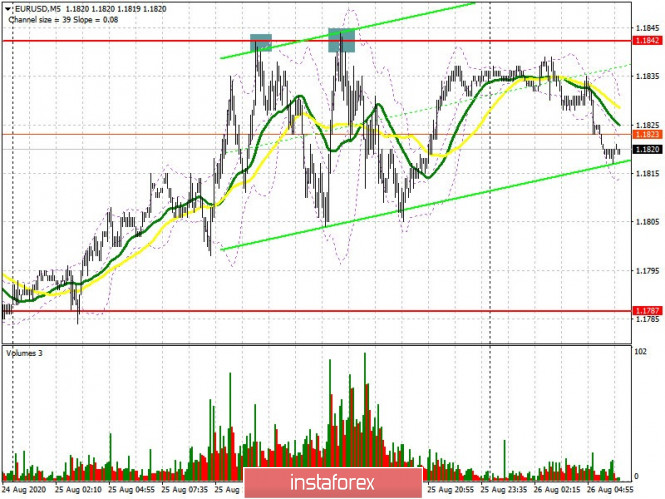To open long positions on EUR/USD, you need:
Yesterday, we waited until a signal appeared to sell the euro from the 1.1842 level, however, weak economic indicators on consumer sentiment in the United States spoiled the entire bearish momentum. Let's figure out where it was necessary to enter the market. If you look at the 5-minute chart and recall yesterday's review for the afternoon, you will see how the bears still achieved a convenient entry point into short positions by forming a false breakout during the repeated resistance test of 1.1842. The downward movement was around 35 points. As a result, nothing has changed for either of them from a technical point of view. Trading remained in the side channel of 1.1787-1.1842, from which an exit is required. I do not recommend rushing to open long positions. It is best to wait for the pair to decline to the major support of 1.1787, since only a false breakout in that area will be a signal to open long positions while counting on a recovery to the high of 1.1842, which is where you can watch the first profit taking. However, an equally important task for the bulls is a breakout and consolidating at the 1.1842 level, since only this will lead to a complete reversal of the downward correction and open the way to a high of 1.1884, where I recommend taking profits. But for such active growth, we need good macroeconomic data, which is not planned today in the economic calendar. If buyers are not active in the support area of 1.1787, it is best to postpone purchases until last week's low has been updated in the area of 1.1755, or open long positions immediately for a rebound from the support of 1.1714 in anticipation of a correction of 20-30 points within the day, since the market is still under the control of bears.
It is also worth recalling that the Commitment of Traders (COT) reports for August 18 recorded a reduction in long non-commercial positions from the level of 266,078 to the level of 259,244, while short non-commercial positions also decreased from the level of 66,327 to 62,301. Given that the closing of long positions turned out to be much bigger, as a result, the positive non-commercial net position sharply fell to 196,943, compared to 199,751 a week earlier. However, such changes did not seriously affect the balance of power in the market, and most likely the demand for the euro will return, after a slight correction of the US dollar.

To open short positions on EUR/USD, you need:
Sellers of the euro will try to break through below the support of 1.1787. Settling below this level forms a good entry point into short positions in anticipation of continuing the downward correction to the area of last week's low at 1.1755, where I recommend taking profits. Support for 1.1714 will be the long-term goal. But do not disregard the bulls' attempts to return to the market, since the triangle that formed on smaller timeframes should be traded. You should see in which direction. It is best to open short positions on the euro's growth only when a false breakout forms at the 1.1842 level, as it was yesterday. If bears are not active, then the market can quickly switch to the side of buyers. In this case, I recommend selling EUR/USD immediately on the rebound but only from a high of 1.1884, counting on a correction of 20-30 points within the day.

Indicator signals:
Moving averages
Trading is carried out in the area of 30 and 50 moving averages, which indicates a small market uncertainty with further direction.
Note: The period and prices of moving averages are considered by the author on the H1 hourly chart and differs from the general definition of the classic daily moving averages on the D1 daily chart.
Bollinger Bands
A breakout of the lower border of the indicator around 1.1815 will increase pressure on the euro. A breakout of the upper border of the indicator in the 1.1842 area will lead to an upward correction.
Description of indicators
- Moving average (moving average, determines the current trend by smoothing out volatility and noise). Period 50. It is marked in yellow on the chart.
- Moving average (moving average, determines the current trend by smoothing out volatility and noise). Period 30. It is marked in green on the chart.
- MACD indicator (Moving Average Convergence/Divergence — convergence/divergence of moving averages) Fast EMA period 12. Slow EMA period to 26. SMA period 9
- Bollinger Bands (Bollinger Bands). Period 20
- Non-commercial traders are speculators, such as individual traders, hedge funds, and large institutions that use the futures market for speculative purposes and meet certain requirements.
- Long non-commercial positions represent the total long open position of non-commercial traders.
- Short non-commercial positions represent the total short open position of non-commercial traders.
- Total non-commercial net position is the difference between short and long positions of non-commercial traders.















 Download NOW!
Download NOW!
No comments:
Post a Comment